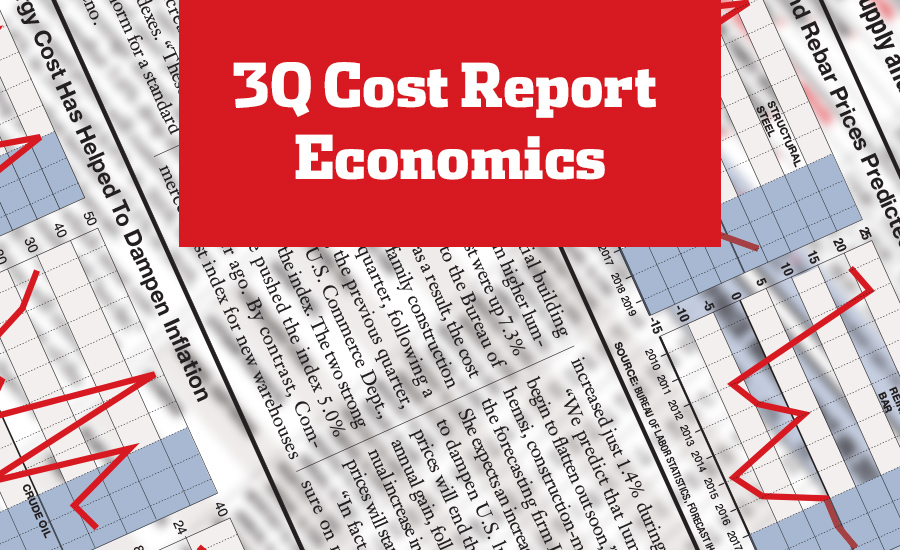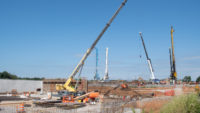Despite several years of recovery, construction inflation is still feeling the impact of the recession that reduced the number of subcontractors and, in turn, still is pushing up bids. “There is plenty of demand out there, and we see a lot of general contractors, but they are all chasing the same subcontractors,” says John Moreno, chief estimator for the cost consulting firm Sierra West.
This pressure can be seen in selling price indexes when they are compared to the general building index, which mostly measure the input costs of materials and labor (see table, p. 42). For example, in its latest report, the materials component of Sierra West’s general building index was up 0.7% for the year, while the labor component was up 1.6%. In contrast, the firms’ in-place subcontractor costs was up 10.8% for the year.
This trend also is reflected in the Rider Levett Bucknall selling price index, which is up 5.8% for the year compared to an average 2.2% increase for five general-purpose cost indexes. “These sub shortages are not the norm for a standard economy,”says Moreno.
|
Click to View the Third-Quarter Cost Report |
Inflation in the residential building market is getting a push from higher lumber prices, which in August were up 7.3% for the year, according to the Bureau of Labor Statistics. Partly as a result, the cost index for new single-family construction jumped 2.6% this quarter, following a 2.0% gain during the previous quarter, according to the U.S. Commerce Dept., which compiles the index. The two strong quarters have pushed the index 5.0% above a year ago. By contrast, Commerce’s cost index for new warehouses increased just 1.4% during the last year.
“We predict that lumber prices will begin to flatten out soon,” says Deni Koenhemsi, construction-materials analyst for the forecasting firm IHS Global Insight. She expects an increase in Canadian imports to dampen U.S. lumber prices and that prices will end the year averaging a 3.2% annual gain, followed by another 3.5% annual increase in 2017. However, she predicts prices will start to weaken in 2018 and 2019.
“In fact, I see little inflationary pressure on most construction materials, which are generally oversupplied and have low input costs,” Koenhemsi says.
In addition, she notes, “demand from China has not been as robust as in previous years.”
One of the cornerstones of IHS’s modest forecast for construction-materials costs are extremely low energy costs. However, the firm warns that prices may bounce back in 2017 before settling down again. Natural-gas prices have fallen 60% over the past two years. They are expected to rebound 34.3% next year before falling again in 2018, IHS predicts. A similar trend is forecast for crude-oil prices. Gasoline prices have fallen for four consecutive years, including last year’s 35.8% drop and this year’s expected 18.2% decline. Next year, gasoline prices are forecast to return to 2015’s low level, which still should leave plenty of bargains at the pump, according to IHS.
“Steel prices are at or past the bottom but are still a lot lower than last year,” says John Anton, steel analyst for IHS. Reinforcing-bar prices fell to $499 at the start of this year from around $683 a ton at the beginning of 2014; since then, they have been “wiggling sideways” in the low $500-a-ton range, says Anton.
“Structural-steel prices did not fall as far as rebar, so they still have more of a downside,” says Anton. He predicts that structural-steel prices will follow last year’s average annual decline of 11.1%, with another 3.0% drop this year. Structural-steel prices will continue to decline 2.8% in 2017 and 0.9% in 2018, before posing a modest increase of 2.5% in 2019, according to the IHS forecast.
Scrap prices, from which most construction products are made, fell “too far,” says Anton, going to $155 a ton now from $379 a ton in 2014. Prices will rebound to only $165 for most of the rest of the year. “It’s a good time to be a buyer,” says Anton. “There is not much of a chance of overpaying.”



